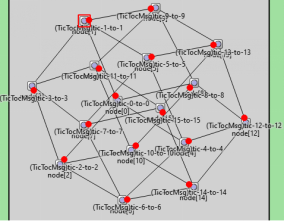文章目录
- 实验介绍
- 实验内容:
- 步骤
- 具体步骤
- 1 构建网络图
- .ned
- 节点模型
- 网络模型
- 2 写路由算法
- .cc
- msg.h
- msg.cc
- 3 启动网络
- .ini
实验介绍
编程实现一个4维的立方体网络仿真,网络节点按照如下方式运行,
实验要求:
1.网络节点按照默认的顺序,如节点标识0,1,…,15从小到大的顺序依次产生一个数据包。
2.节点产生(或接收到)一个数据包后,随机选择一个相邻节点发送数据包,依此规则重复执行,直至产生数据包的节点接收到自己的数据包后,直接删除该数据包。
超级立方体网络指具有 d 个维度的网络具有2d个网络节点,网络节点按照0,1,2,…2d-1顺序进行编号。标识 i 的节点采用二进制方式可表示为d 位的二进制序列,网络任意两个节点二进制形式表示的d位标识符,对应位只有某一位不同时,表示节点是直接相邻接,否则,两个节点之间不存在直接相邻接。例如,对于一个3维的超级立方体网络,网络中存在8(8 = 23)个网络节点,如0(000),1(001) ,2(010) ,3(011) ,4(100) ,5(101) ,6(110) ,7(111)。网络拓扑结构按照如下方式连接,节点 0(000)与节点1(001) ,2(010) ,4(100) 直接相临接,因节点 0(000)与节点1,2,4分别在第1位,第2位,第3位不同(从左往右数),其他节点按此规律相邻接。
实验内容:
1.生成4维超立方体网络模型图及网络运行截图;
2.画出网络流程框图;
3.写出节点随机选择相邻节点的路由算法伪代码
4.统计每个节点产生的数据包一个轮回产生的跳数,同时,统计每个节点发送、接收的数据包的个数。
步骤
- 构建4维的立方体网络网络模型图,编写.ned代码
- 写出节点随机选择相邻节点的路由算法,编写.cc代码
具体步骤
1 构建网络图
先上图,生成的模型图如下(参考hypercube )

.ned
自己 new 一个 project(注意是empty project),再project中新建一个.ned文件。
工程创建参考:link
节点模型
simple Node
{
parameters:
int dim = default(4);//维数,默认为4,可自行修改生成各种维数的立方体
@display("i=block/circle;is=vs");
gates:
inout gate[dim];//根据维数构建输出输入门
}
网络模型
network Hypercube
{
parameters:
int dim = default(4);
types:
channel Channel extends ned.DelayChannel {
delay = 100ms;
}
submodules:
node[2^dim]:Node;
connections:
for i=0..2^dim-1, for j=0..dim-1 {.
node[i].gate[j] <--> Channel<-->node[i#(1<<j)].gate[j] if (i < i#(1<<j));//关键代码
//此句代码将根据维数生成按照如下方式连接的网络拓扑结构:例如三维:节点 0(000)与节点1(001) ,2(010) ,4(100) 直接相临接,因节点 0(000)与节点1,2,4分别在第1位,第2位,第3位不同(从左往右数),其他节点按此规律相邻接。
}
}
2 写路由算法
.cc
在project中,新建一个.cc文件
#include <omnetpp.h>
#include "msg.h"
#include <stdio.h>
using namespace omnetpp;
class Node: public cSimpleModule
{
private:
int hop;
int sendCounter;//存储发送数目
int recCounter;//存储接受数目
int dim;//维数
int pointCounter;//根据维数生成的节点数目
protected:
virtual TicTocMsg *generateMessage();
virtual void initialize() override;
virtual void handleMessage(cMessage *msg) override;
void SendRandomMessage(TicTocMsg *msg);//随机选择从该节点的 一个节点发送消息出去
};
Define_Module(Node);
void Node::initialize()
{
hop=0;
sendCounter=0;
recCounter=0;
pointCounter=1;
WATCH(hop);
WATCH(sendCounter);
WATCH(recCounter);
//根据维数生成相应数量的点
dim = par("dim");
for(int i=0;i<dim;i++)
pointCounter*=2;
EV<<"pointCounter"<<pointCounter<<endl;
for(int i=0;i<pointCounter;i++)
{
if (getIndex() == i) {
EV<<"node "<<i<<" :start!"<<endl;
TicTocMsg *msg = generateMessage();//产生消息
SendRandomMessage(msg);//随机选择一个门发送出去,随机转发算法
}
}
}
void Node::handleMessage(cMessage *msg)
{
recCounter++;//处理消息,即接受到消息,接受消息数目+1
TicTocMsg *ttmsg = check_and_cast<TicTocMsg *>(msg);//转化类型
//消息到达目的节点,打印调数,删除旧消息,生成新消息,随机发送消息
if (ttmsg->getY() == getIndex()) {
// Message arrived.
EV << "Message " << ttmsg << " arrived after " << ttmsg->getHopCount() << " hops.n";
hop = ttmsg->getHopCount();//统计消息到达时的hop
bubble("ARRIVED");//在网络视图中 产生 对话框,
delete ttmsg;
}
//消息没到达目的节点,随机转发
else
{
SendRandomMessage(ttmsg);//随机转发
}
}
void Node::SendRandomMessage(TicTocMsg *msg)
{
// Increment hop count.
//发送出去,跳数+1,发送数目+1
msg->setHopCount(msg->getHopCount()+1);
sendCounter++;
// Same routing as before: random gate.
int n = gateSize("gate");
EV<<"gataSize:"<<n<<endl;
int k = intuniform(0, n-1);
EV << "Forwarding message " << msg << " on gate[" << k << "]n";
send(msg, "gate$o", k);//$0表示从out门发送出去
}
//生成消息,
TicTocMsg* Node::generateMessage()
{
int src = getIndex();
// our module index
int dest = src;//据题意:目的节点就是源节点
char msgname[20];
sprintf(msgname, "tic-%d", src);
// Create message object and set source and destination field.
TicTocMsg *msg = new TicTocMsg(msgname);
msg->setX(src);
msg->setY(dest);
return msg;
}
msg.h
自定义消息头文件
#ifndef MSG_H_
#define MSG_H_
#include <omnetpp.h>
class TicTocMsg;
class TicTocMsg : public ::omnetpp::cMessage
{
protected:
int x = 0;//存储源地址,这里命名有点low
int y = 0;//存储目的地址,命名不规范
int hopCount = 0;//存储跳数
private:
void copy(const TicTocMsg& other);
protected:
// protected and unimplemented operator==(), to prevent accidental usage
bool operator==(const TicTocMsg&);
public:
TicTocMsg(const char *name=nullptr, short kind=0);
TicTocMsg(const TicTocMsg& other);
virtual ~TicTocMsg();
// field getter/setter methods
virtual int getX() const;
virtual void setX(int source);
virtual int getY() const;
virtual void setY(int destination);
virtual int getHopCount() const;
virtual void setHopCount(int hopCount);
};
#endif /* MSG_H_ */
msg.cc
自定义消息实现文件
#include "msg.h"
#include <iostream>
#include <sstream>
#include <memory>
namespace omnetpp {
}
void TicTocMsg::copy(const TicTocMsg& other)
{
this->x = other.x;
this->y = other.y;
this->hopCount = other.hopCount;
}
TicTocMsg::TicTocMsg(const char *name, short kind) : ::omnetpp::cMessage(name, kind)
{
}
TicTocMsg::TicTocMsg(const TicTocMsg& other) : ::omnetpp::cMessage(other)
{
copy(other);
}
TicTocMsg::~TicTocMsg()
{
}
int TicTocMsg::getX() const
{
return this->x;
}
void TicTocMsg::setX(int source)
{
this->x = source;
}
int TicTocMsg::getY() const
{
return this->y;
}
void TicTocMsg::setY(int destination)
{
this->y = destination;
}
int TicTocMsg::getHopCount() const
{
return this->hopCount;
}
void TicTocMsg::setHopCount(int hopCount)
{
this->hopCount = hopCount;
}
3 启动网络
.ini
网络配置
[General]
network = Hypercube
欢迎读者们提出你们宝贵的建议。
最后
以上就是坚定麦片最近收集整理的关于omnet++ 4维的立方体网络仿真实验介绍的全部内容,更多相关omnet++内容请搜索靠谱客的其他文章。








发表评论 取消回复